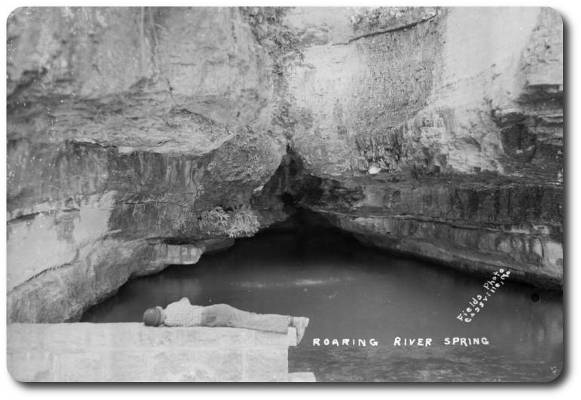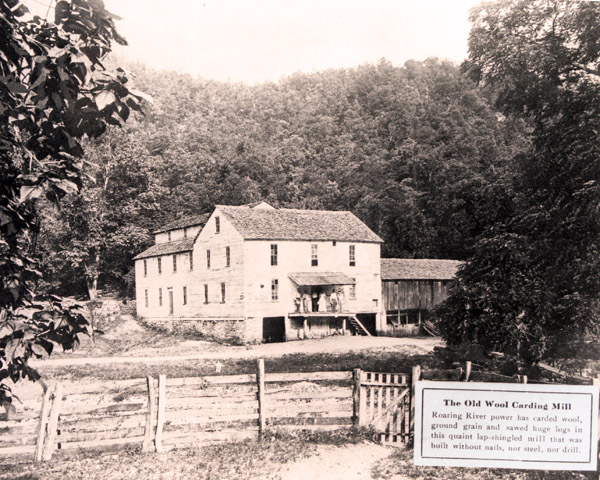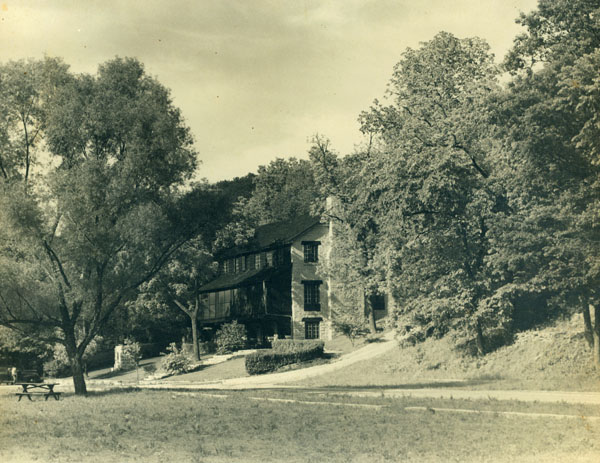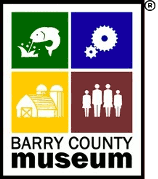Roaring River
Mountain Maid
Roaring River State Park
 |
 |
|---|---|
Roaring River Spring |
Roaring River Hatchery |
National Register of Historic Places Inventory
| The History of Roaring River |
|---|
| The story of stone and bone left behind by the American Indian is today more important than ever before. It has been revealed that Indian villages or settlements were at one time or another situated on practically every spot near Roaring River. This deep river valley with its ever-sheltering bluffs protected from the heavy snows, its gushing spring, its bountiful supply of wild life, and the many Indian tepees or lodges dotting the river's edge on both sides, must have been a different kind of world - a paradise, indeed! According to the Missouri Historical Review, the first white man in southwest Missouri region was a native of Tennessee who was known as Edmund Jennings. After fifteen years of living with the Indians and roaming the "happy hunting grounds" of the area, Mr. Jennings returned to his native land in the 1820's. The First Humble little cabin in the Roaring River area was reportedly built in the early 1830's by Charles Haddock. According to John Haddock of Cassville, his great grandfather erected this first house near the river about three miles southeast of Roaring River spring. -Roaring River Realities by Wanda Brewer Henry McCary, one of Barry County's pioneers, recalled in an address prepared for the 1876 Centennial Celebration in Cassville, that when he arrived in the fall of 1836, there was a small tub mill at the Roaring River spring. -The First 150 Years by Senator Emory Melton The first mill know as a small tub mill was made of native timber and stone - even the burrs were made from native limestone rock. In order to provide the power needed for this mill, water was conveyed in a trough down to the mill wheel about a hundred feet from the spring. One of the greatest manifestations of progress made by those early settlers was the erection of a gristmill near the Roaring River spring. In 1848 Thomas Ruble homesteaded the land on which the mill was located, the records showing that eighty acres of this land were purchased from the United States Government by Mr. Ruble for the total sum of $100.00. -Roaring River Realities by Wanda Brewer In 1853, Mr. Ruble sold the land and the mill to Barton B. Clements who continued operations until the Civil War started in 1861. We can only speculate as to why Clements sold the property in 1861, but contemporary writing indicate that the milling business was a particularly dangerous profession during the War. Mills were tempting targets for foraging parties from not only the Union and Confederate armies, but from Bushwhackers as well. ...Clements sold out in late 1861 to Josiah T. Keet, a native Englishman who was a storekeeper at Keetsville (now Washburn) and William McClure. Clements accurately foresaw the difficult days the War would bring, since the mill built in 1845 was completely destroyed in the War between the States. As soon as the war ended in 1865, plan were made to rebuild the mill which was completed in 1866. -The First 150 Years by Senator Emory Melton In early times, perhaps long before those first settlers arrived, Roaring River itself, originating from that very deep spring which came up in sort of a cave under an overhanging bluff, flowed meanderingly through this hill cupped valley into the White River. Water rose up in great volume from this spring and poured out with a terrific roar, a roar that inspired and gave us the name for our beautiful river which is said to be the shortest in the United States. An interesting development took place, however, with respect to the roar emanating from the spring. When the dam was built in 1865 confining the water over the spring, that perpetual and reverberating roar was brought to an abrupt end and has never been heard since. -Roaring River Realities by Wandy Brewer In 1865 a stone and earth dam was built confining the water over the spring in a deep reservoir to be used in the turning of the mill wheel. This dam and a second mill were built by William McClure. In the erection of this dam, two opening or races were left in the 'mill pond' wall, thus bringing into being the waterfalls which through the years have contributed much to the scenic beauty of the Roaring River area. The second mill, located at the end of the mill race, is now the site of the Park Lodge. The McClure mill not only supplied facilities for grinding grain, but provided a carding machine for detangling and arranging the cotton and woolen fibers, and a spinning wheel and loom for spinning and weaving the yarn. Also, a sawmill was provided for sawing huge logs. -Roaring River Realities by Wanda Brewer With the thriving mills, other business interests started at Roaring River. In 1880, there was: A.M. Farwell's general store, the post office, Rev. J.C. Pearce and Jasper Smith's blacksmith shops, and C.A. Muncey as a cattle dealer. Miss Cora Davis presided over the school at this time. There were two justices of the peace: E. Klean and W.R. Mitchell. Rev. Pearce was a Methodist preacher and Rev. E. Chappel, a Baptist preacher at Roaring River. In March 1888, Rev. Kelly organized the Christian Church of Mount Zion at Roaring River. ...Mail delivery came to the Roaring River community shortly after the turn of thecentury. The roads throughout the area at that time were narrow, winding, rough, and muddy, or dusty as the seasons dictated. But the little lanes that wound through the valleys of the tracks that precariously climbed the hills at Roaring River were worse than most. They had the added hazard of many, many fords, where the road crossed the river. ...The old wagon road from Cassville followed the ridge of the Bald Mountain, where down a steep, rock route, the road wound down a timbered hillside to Roaring River Hollow. What is now known locally as "the old Roaring River Road," entered the north end of Roaring River State Park, and was the only route from Cassville until 1932 when the present Highway 112 was begun. -Roaring River Heritage by Irene Horner The old Critchfield home stood in what is now the camp grounds at the east end of Roaring River State Park near Camp Smokey. The family lived in the house before 1887. The house was located on the lower side of the road and a barn with two log cribs and a driveway between, stood on the upper side of the road. -Roaring River Heritage by Irene Horner The Sills' home was a popular gathering place. A boarding house for some years, it was renowned for its fine meals and musical entertainment, for members of the Sills family were all musically talented. The home was often used for school when it was extremely cold or no fuel was available for the little school nearby. -Roaring River Heritage by Iren Horner |
 |
The old Wool Carding Mill at Roaring River |
| As the mill era ended, the old wool carding mill structure was converted into an inn - with a hundred rooms. Roland Bruner bought 120 acres, including the spring and mill building in 1905. Bruner's life was a roller coaster of wins and losses. He made and lost several fortunes. At Roaring River he made improvements, offered a few lots and cabins for sale, and in 1910 stocked the river with trout from a hatchery he built just below the spring area. He later sold an interest to F. J. Banister, who also made a few improvements, Including two houses across from the Hotel. -Roaring River Heritage by Irene Horner But the Bruner-Bannister partnership did not go well. On April 19,1922, the Roaring River holdings were mortgaged to a Kansas City firm and in 1928, about 2500 acres of land were offered in a foreclosure sale on the courthouse steps in Cassville. At the time of the foreclosure sale, the property included a saw mill, hydro-electric plant, electric laundry, refrigeration plant, ice plant and Roaring River Camps and Hotel. Bruner's losses were heavy, the Great Depression was at Hand, and he was no longer a young man. He never recouped. He died in 1940. He had lived in times when the sky was the limit - but sometimes the sky could fall. -Roaring River Heritage by Irene Horner |
 |
Roaring River Hotel 1920s |
| Crown Point sat on the location that is presently the Emory Melton Convention Center. It was owned by Barb Selter's Grandparents, Mr. and Mrs. Oscar Reitz. It served as their summer home for years and eventually became their permanent home. On Friday, November 16, 1928, a foreclosure sale took place. The usual crowd had gathered for what seemed to be an ordinary proceeding. However, when the bidding started, a surprising turn of events took place. An unassuming stranger dressed in hunting clothes and standing aloof from the crowd, started bidding very competitively for this tract of land comprising the Roaring River Spring. When a sizable figure was reached that seemed almost unbelievable to the local bidders, the stranger was asked, "Mister, do you realize this is a cash sale?" His reply was in the affirmative, and when the bidding was over, the new owner of this beautiful Ozark playground was none other than Dr. Thomas M. Sayan, the famous soap manufacturer of St. Louis. Rumors circulated like wild fire as to the plans the St. Louis soap manufacturer had for the beautiful property. ...He soon realized that his plans could not be carried out. On December 5, 1928, he presented the entire tract of 2400 acres to the State of Missouri for a park - and Roaring River State Park came into being. -The First 150 Years by Senator Emory Melton L. R. Chambers was the first superintendent at Roaring River after it became a state park, taking charge in 1929. Even back in 1932, Roaring River drew throngs of people. It was reported that each weekend thousands of people visited the park. -Roaring River Heritage by Irene Horner No story of Roaring River would be complete without the chronicle of the Civilian Conservation Corps. Company 1713, CCC, was organized at Ft. Leavenworth, Kansas, in June 1933, and was moved to its location at Roaring River Park in the same month. At the time of the arrival of the first CCC workers, Roaring River was just beginning to attract attention as a summer resort. During the next seven years, the CCC built thirty-three building units, mostly of logs or stone quarried by the men, seventeen acres of beach improvements, six acres of landscaping, many miles of roads and trails, fish runs, a hatchery building...the list could go on and on. -Roaring River Heritage by Irene Horner Old timers at Roaring River still refer to the "time of the flood," as being in May of 1939, for this was the park's most damaging inundation by spring flood waters. The hatchery building suffered the heaviest damage of any building from the flood's swirling force. The concrete foundation was swept away, and several hundred dollars worth of equipment was lost in the raging torrent as the building toppled. The dining pavilion, which had been used through the years until the new hotel was ready for occupancy, was undermined by the flood and one corner collapsed. This building was soon done away with.-Roaring River Heritage by Irene Horner March 1st, opening day of trout season, has long been a day of excitement for locals as well as tourists. And the Tradition Continues... |
 |
Roaring River Lodge 1940s |

